
Aaargh! is a single-player action video game in which the player controls a giant monster with the goal of obtaining eggs by destroying buildings in different cities across a lost island. It was designed for Mastertronic's Arcadia Systems, an arcade machine based on the custom hardware of the Amiga, and was released in 1987. It was ported to a range of other platforms and released on these across 1988 and 1989. Electronic Arts distributed the Amiga version of the game.

Tornado Low Level is a multidirectional shooter developed by Costa Panayi and published in 1984 by the company he co-founded, Vortex Software. The game was released for the ZX Spectrum in 1984, with ports for the Amstrad CPC and Commodore 64 in 1985.
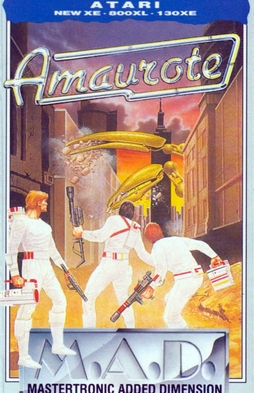
Amaurote is a British video game for 8-bit computer systems that was released in 1987 by Mastertronic on their Mastertronic Added Dimension label. The music for the game was written by David Whittaker.

Cyclone is a multidirectional helicopter game for the ZX Spectrum released by Vortex Software in 1985. It was written by Vortex co-founder Costa Panayi who also coded the similarly styled Tornado Low Level.
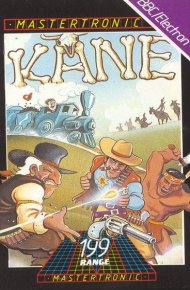
Kane is a multi-section action game published by Mastertronic for the Commodore 64 in 1986. It was ported to the Acorn Electron, Amstrad CPC, BBC Micro, ZX Spectrum, and the Commodore 16 and Plus/4. The game is set in the Wild West, and its name is a reference to the main character of the film High Noon. It consists of four distinct scenes, although some versions only contain two. A sequel was released in 1988.
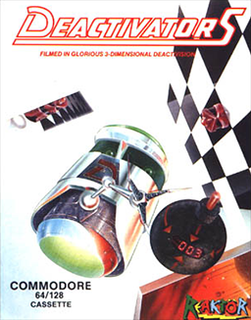
Deactivators is a 1986 puzzle video game designed by David Bishop and Chris Palmer, developed by Tigress Marketing and System Software, and published by Ariolasoft's action game imprint Reaktor. The player controls bomb disposal robots known as deactivators and must use them to deactivate bombs planted by terrorists in five research complexes. The concept for the game came from a brainstorming session between Bishop and Palmer; its design and development took five to six months to complete. It was released for the Amstrad CPC 464, Commodore 64, and ZX Spectrum platforms in October 1986.

Action Force: International Heroes is a video game released by Virgin Games in 1987 for the ZX Spectrum and Commodore 64, and in 1988 for the Amstrad CPC. The game is set in the world of the Action Force toys by Hasbro. The ZX Spectrum version of the game differs notably from the Commodore and Amstrad versions.

Agent X II: The Mad Prof's Back is a computer game released in 1987 for the ZX Spectrum, Amstrad CPC and Commodore 64. It is the follow-up to the ZX Spectrum game Agent X.

Zub is a 1986 platform video game designed by Ste and John Pickford, developed by Binary Design, and published by Mastertronic for the Amstrad CPC, Commodore 64 and ZX Spectrum. The game has the player control Zub, who has to travel to different planets to retrieve the Green Eyeball of Zub. A parody of the game Light Force, called Lightfarce, was added in as an easter egg. The music on all computers was composed by David Whittaker.

Chequered Flag is a racing video game developed by Steve Kelly for Psion Software and published by Sinclair Research in 1983. It was the first driving game published for the ZX Spectrum and one of the first computer car simulators.

Cobra is a 1986 platform game based on the film of the same name. It was developed and published by Ocean Software, and was released in Europe for Amstrad CPC, Commodore 64 (C64), and ZX Spectrum. By 1990, it received a budget re-release.

Attack of the Killer Tomatoes is a computer game released in 1986 for the Sinclair Spectrum, Amstrad CPC and MSX. It is based on the 1978 comedy film of the same name.

The Dukes of Hazzard is a 1984 racing video game developed and published by Coleco for their ColecoVision game console and Coleco Adam computer. Elite Systems released a different game with the same title for the ZX Spectrum computer on February 23, 1985. Both versions are based on the television series of the same name.
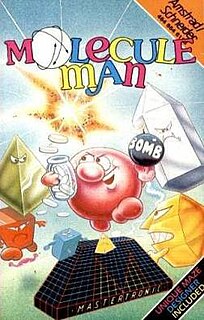
Molecule Man is an isometric 3D action-adventure video game released by Mastertronic in 1986 for a variety of 8-bit home computers. A level editor is included which enables the player to design their own mazes.
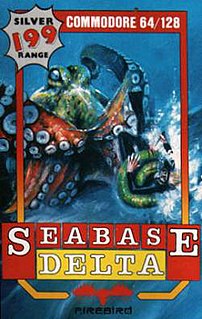
Seabase Delta is a text adventure game by Firebird released in 1986 for the Amstrad CPC, Commodore 64, and ZX Spectrum home computers. It is the sequel to Subsunk.
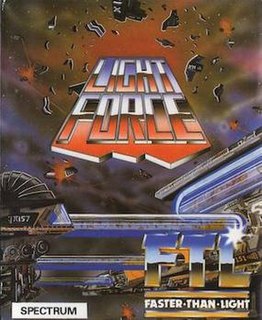
Light Force is a 1986 vertically scrolling shooter designed by Greg Follis and Roy Carter, developed by their company Gargoyle Games, and published under their Faster Than Light imprint. It was released for the Amstrad CPC, Commodore 64, and ZX Spectrum platforms.
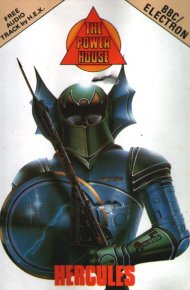
Hercules is a platform video game written by Steve Bak for the Commodore 64 and published by Interdisc in 1984. It was reissued in 1986 by Alpha Omega and ported to the Acorn Electron, BBC Micro, Commodore 16, Plus/4, and ZX Spectrum. Alpha Omega changed its name to The Power House shortly after publishing the game.

Moonlight Madness is a video game for the ZX Spectrum home computer, published in 1986 by Bubble Bus Software. It is an arcade adventure game in which players control a boy scout. The object of the game is to unlock a safe within a mansion to obtain pills for the mansion's owner, a mad scientist, who has collapsed. This requires the player to traverse the mansion's rooms while avoiding hazards such as dangerous house servants and fatal falls.

Top Gun is a 1986 combat flight simulation game based on the film of the same name. It was developed and published by British company Ocean Software, and was released for several computer platforms. In the United Kingdom, it was released for Amstrad CPC, Commodore 64, and ZX Spectrum in December 1986. The following year, it was released for Atari ST. In the United States, it was published by Thunder Mountain. In 1989, it was published by The Hit Squad as a budget re-release for ZX Spectrum and Commodore 64.

Knight Rider is a 1986 video game based on the series of the same name. It was developed and published by Ocean Software, and was released in Europe for Amstrad CPC, Commodore 64, and ZX Spectrum.





















